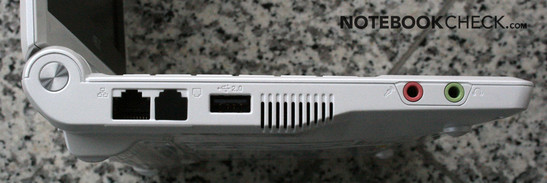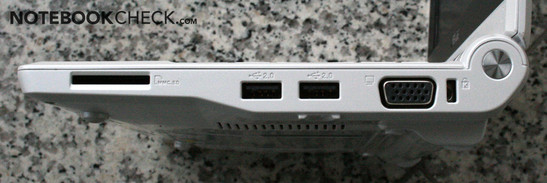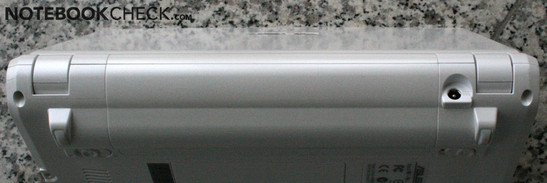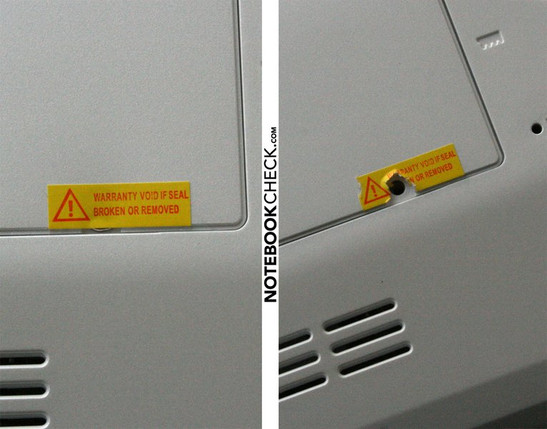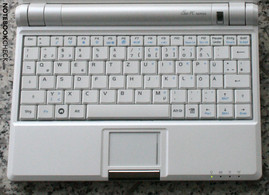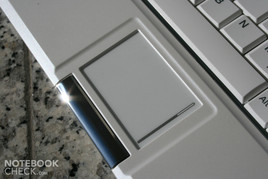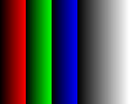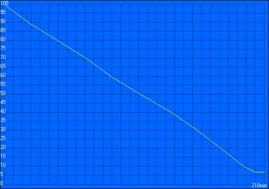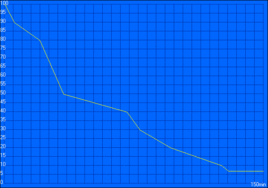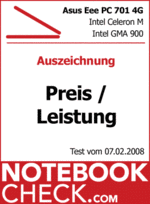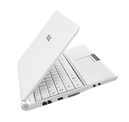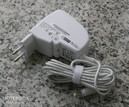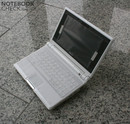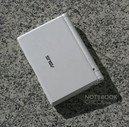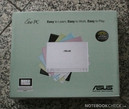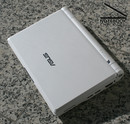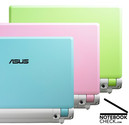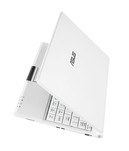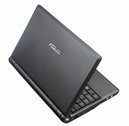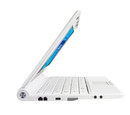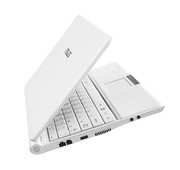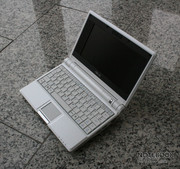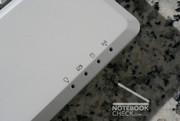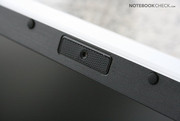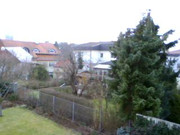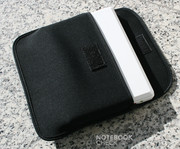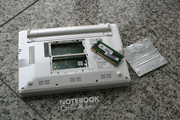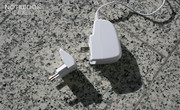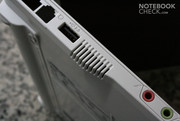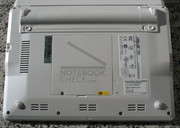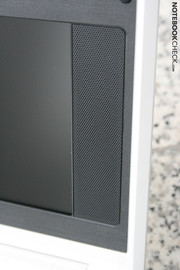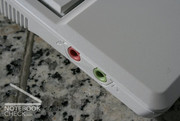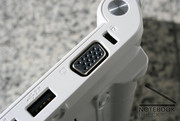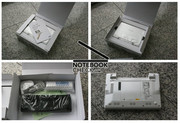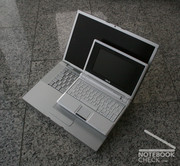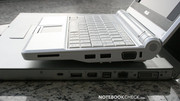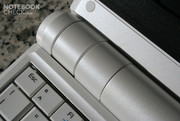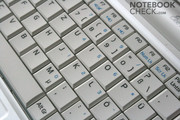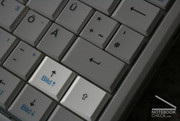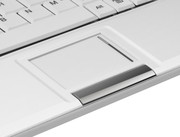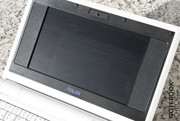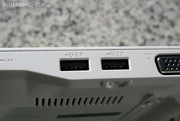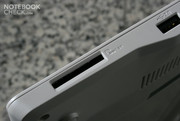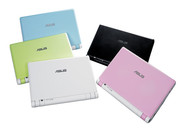Review Asus Eee PC 4G Subnotebook
Family PC - According to Asus this small and reasonable notebook is a notebook for the whole family. Here you can read how it performed in our technical tests and whether it is able to actually replace the classical PC.

Case
The big display hinge (combined with battery) dominates the design of the Eee PC. Overall it looks good - rather decent. The only optical highlight are the two stereo speakers located beside the display. They make the display look like providing 4:3 format on a wide-screen TV. Due to the striped frame this still looks good. The used materials look good and feel nice to the touch too.
The flexural rigidity of the bottom trough is without doubt very good. It hardly yields under pressure, so that it is able to safely protect the inner parts. The same is true for the lid.
Gaps are overall even and the battery is attached tightly to the case, something, which one cannot take for granted as other notebooks prove.
The dominating display hinge appears to be robust and supports every adjusted opening angle without any see-saw. The Eee PC has no transport hook, so, you should carry it in the provided protective cover.
Considering the small case the interface equipment is generous. LAN, WLAN, 3x USB, headphone, microphone, SD/MMC card reader (for increasing the memory capacity), and VGA are at the left or right sides of the case. Beside a 10/100 MBit LAN port there is also a modem port, which is covered by a plastic cover. We suspect that it is not connected, because also the manufacturer does not list it. According to Wikipedia only the 4G (a model which does not support extensively browsing the Internet) provides an integrated modem.
The built-in WLAN card by Atheros worked combined with our WLAN router Trendnet TEW-633GR without problems. Under Linux and Windows XP we only needed to key in the WPA password. Afterwards we had a stable connection.
The built-in 0.3 MegaPixel web cam has to be activated in the BIOS first. Afterwards you can either use it with the UVC camera tool (for pictures and videos) or if you download the newest Skype Beta 2.0 for Linux also for video chats in Skype. The quality of the pictures is sufficient for simple video chats.
Furthermore, there is a small cover fixed with two screws at the bottom side of this very small notebook. Beneath it you'll find the single, but, replaceable memory module. Although it says, that you'll loose warranty, if the seal is broken, you shouldn't have any problems, if you replace the memory in a professional manner. In the meanwhile this has also been confirmed by Asus via media (News in German).
Input Devices
The first serious weakness of the Asus Eee PC notebook is that its keyboard is, because of its total size, small. The size of the keys is only 16 mm x 14 mm (13 mm x 13 mm at the top, the size of the umlauts is even only 11 mm x 13 mm). So, only persons with small finger are able to touch type and this only after some time of getting used to the small keys. Because of very little space, also the keyboard layout had to be changed. Thereby it is most annoying that the right shift key was somewhat moved to the right. So, you'll hit the 'cursor up' key again and again instead. This is most annoying if you work with a Linux shell.
The keyboard itself is attached sufficiently tight, the key feedback is very clear, and the key travel sufficient. Besides the layout problem with the shift key, the keyboard is considering the size of the notebook in general alright.
The touch pad reacts sensibly and has an scroll area, but, its size is only 45 x 31 mm², which is very small. With standard settings it is just possible to move the mouse pointer from one side to the other. Despite this, you'll knock against its borders again and again. Primary and secondary mouse button are designed as chrome moulding with toggle push button. So, clicking works only on the outer third of the button. Here you'll need some time to get used to too.
Display
The small 7" TFT display with LED background lightening is surely the weakest point of the Eee PCs. Due to the small resolution of only 800x480 pixels the desktop size is clearly too small. Sometimes even system dialogues cannot completely be displayed, whereas this is true under Windows XP and standard Linux desktop). So, you need to hide the task bar and if this is still not sufficient, you need to blind choose the proper option with tab and enter. Under Windows, there is a tool, which sets the resolution to 800x600 and allows scrolling.
Furthermore, the maximum brightness of only 91.6 Candela is rather low. This is sufficient for working indoors, but, it is hardly possible to work outside in the sunshine. So, you cannot really gain profit from the otherwise good mobility of this very small notebook. To summarize, a trans-reflecting display or a better background lightning would have been better choices. Also due to the small size of the display the viewing angles are relatively good.
| |||||||||||||||||||||||||
Brightness Distribution: 84 %
Contrast: 366:1 (Black: 0.25 cd/m²)
It's easy to enhance the available desktop size by connecting an external screen to the VGA out. However, the pre-installed Linux supports only a resolution of up to 1024x768 pixels at the external screen. Under Windows XP we could run the external screen with usable definition with a resolution of up to 1280x1024 at 75 Hz.
Compared to the reference screen (Dell 2407WFPD) the colours appear to be somewhat cold. The low black value of 0.25 Candela gives together with the maximum brightness an acceptable contrast ratio of 366:1. However, because of the low maximum brightness you won't really notice this.
Horizontally the viewing angles are good, i.e., the contrast stays a long time at nearly the same level. Looking top down, the colours change much faster. However, due to the small panel size this is hardly a big problem.
Performance
Due to a Celeron-M CPU and integrated video chip (GMA 900) the performance of this reasonable small notebook is rather moderate. The Celeron M, specified with 900MHz was due to reducing the FSB clock rate from 100 MHz (FSB 400) to 70 MHz (FSB 280) with 630 MHz lower clocked. Therefore the performance is rather poor.
When displaying complex web pages, we noticed a short delay, which was not really annoying.
This is also proved by the PCMark 05 benchmark. The Eee-PC is worse than all other notebooks reviewed so far, but, surprisingly, only slightly worse than the Samsung Q30 with Intel Pentium M 753 1.2 GHz ULV processor.
Its 3D Mark 2001 benchmark results are even better than those of two of its subnotebook competitors (Sony Vaio VGN-TX2XP/B and Nexoc Osiris S607). The performance is still absolutely insufficient for playing 3D games. Only Quake 3 Arena, a rather old game, was playable with an average of 31 fps (1024x768 - high). Warcraft 3 was playable in single user mode, but not very well (20 fps in single player mode with some details). The Aquamark test resulted in´2632 points (starting with 3000 Aquanox should be playable with low details). Doom 3 was even with low details far away from running smoothly. 2.8 fps are the speed you change pictures in a slide show. We ran all test with the provided, out-of-date video driver (6.14.10.4704) for GMA 900. Running test with the newest driver downloaded from Intel's homepage (6.14.10.4764) resulted in less points in the 3D Mark 2001 benchmark and a crash of the 3D Mark 2003.
Bigger notebooks with Intel or AMD processor perform clearly better in this aspect. However, games are not the field of operation the Eee PCs was designed for.
The performance of the Eee PC is sufficient for daily work. We could start working with the pre-installed and adapted Xandros Linux already 26 seconds after we turned the computer on. The OpenOffice software bundle ran without problem and without longer delays. The same is true for browsing the Internet. This small notebook could also handle most video format (YouTube, DivX, DVD from external HDD) without problems. However, its performance was not sufficient for HD videos. Of course you'll need a modern core duo processor for watching HD videos.
To summarize, the Family notebook is no portable gaming notebook, but fast enough for Office and Internet applications.
| Quake 3 Arena - Timedemo | |||
| Resolution | Settings | Value | |
| 1024x768 | highest, 0xAA, 0xAF | 32.1 fps | |
| Doom 3 | |||
| Resolution | Settings | Value | |
| 640x480 | Low, 0xAA, 0xAF | 2.8 fps | |
| 3DMark 2001SE Standard | 1726 points | |
| 3DMark 05 Standard | 279 points | |
Help | ||
| PCMark 05 Standard | 855 points | |
Help | ||
Compared to the slow 1.8" hard disk of the Samsung Q30 the SSD hard disk by SiliconMotion inside the Eee PC is excellent. The constantly high transfer rate of about 30 MB per second is noticeable. However, compared to up-to-date high-performance notebook hard disks, e.g., a Hitachi Travelstar HTS722020K9SA00 inside the Schenker MySn M570RU the transfer rates appear low. The Hitachi runs at 7200 rpms and has transfer rates in between 30 and 66 MB/s. The SSD has a access time of only 0.5 ms and clearly outperforms the Hitachi regarding this aspect, whose access time is 15 ms. Overall the SDD is regarding performance alright. However, its capacity is low.
You can enhance the low hard disk capacity by, e.g., attaching an external hard disk. The reviewed one had a transfer rate of nearly 20 MB/s (in comparison: desktop PC with P5B attached to USB Hub: 25 MB/s, MacBook Pro: 30 MB/s).
Emissions
Even in idle mode the fan starts running after about 20 minutes and keeps running afterwards. Because of the small case and because the Intel Celeron comes without speed-step technology this is no surprise. It seems that the processors clock rate is reduced to 112 MHz in idle mode under Linux though. Nonetheless, the fan reacts very similar under Windows and Linux. Actually, we didn't notice any difference.
Although the whirring of the fan is rather quiet, it is accompanied by a nasty high frequency noise. Due to its inherent technology the SSD hard disk is nearly utterly quiet during the first 20 minutes. Even if you put your ears onto the case you will hardly hear anything.
Noise level
| Idle |
| 28 / 35.5 / 35.5 dB(A) |
| HDD |
| 28 dB(A) |
| Load |
| 35.5 / 36 dB(A) |
 | ||
30 dB silent 40 dB(A) audible 50 dB(A) loud |
||
min: | ||
Temperature
The temperature of this small notebook increases to up to 39°C in area of the keyboard. However, we didn't feel that this is disturbing (test in winter), because the maximum temperature of the palm rest area was 36°C, which is alright. In summer, if it's hot, this could lead to sweating hands.
(+) The maximum temperature on the upper side is 39.2 °C / 103 F, compared to the average of 33.1 °C / 92 F, ranging from 21.6 to 53.2 °C for the class Netbook.
(+) The bottom heats up to a maximum of 36.3 °C / 97 F, compared to the average of 36.6 °C / 98 F
(±) The palmrests and touchpad can get very hot to the touch with a maximum of 36.8 °C / 98.2 F.
(-) The average temperature of the palmrest area of similar devices was 29.3 °C / 84.7 F (-7.5 °C / -13.5 F).
Speakers
The two stereo speakers besides the display are not really loud and without basses, but there sound is clear. So, they are fit for background music and sound of videos.
Audio out via the provided Sennheiser PC 150 headset is flawless. Even at maximum volume the sound was undistorted and without disturbing noise.
Battery Runtime
The runtime of the 38.5 Wh battery, which weighs nearly 200g, ranges depending on the load from 2 to 3h. The difference between idle mode and full load is low, because their energy demand is very similar. Because the notebook comes quickly back from stand-by mode, the battery is sufficient for occassionally use during the day (accessing mail, writing, browsing the Internet).
This small notebook does not demand a lot of energy. Only between 13 and 18 Watt are energy demands, which are worth mentioning, especially in times of increased environmental awareness. However, the energy demand in stand-by mode is rather high. Especially bad: During our review the energy demand of the Eee PC was even 4 Watt when turned off.
| Off / Standby | |
| Idle | |
| Load |
|
Key:
min: | |
Missing USB DVD Drive
After a software update the reviewed notebook brought only up a black desktop. We could not start the menu any longer. Obviously the simpleui.rc was corrupted by the Asus Update Utility. We tried to fix the problem, by restoring the original file from the recovery partition. Unfortunately there was no recovery partition on the reviewed notebook. So, we had to restore via USB CD-ROM drive or via sufficiently big USB stick. Unfortunately, we could not get hold of any of them during our short test period.
In order to get the operating system image on a CD, we accessed the Asus CD via a desktop CD drive. The software immediately prompted us to provide the AsusACPI driver (of course for the EeePC, as we saw later on). Unfortunately, FreeOS, a tool for copying images, did not recognize the external hard disk, which was FAT32 formatted.
Finally we found the original file on this web page:
http://wiki.eeeuser.com/list:simpleui.rc
Unfortunately, there was still no success. The launcher still claimed that the file were corrupt. The final solution was to format a CompactFlash card via USB card reader (we used the one of our digital camera, which was sufficiently big) and to copy the recovery system onto it. Restoring was, after booting from CompactFlash card (ESC for boot menu), pretty easy.
Following these instructions (German) we also installed Windows XP on the Eee PC.
Verdict
Easy to Learn, Easy to Work, Easy to Play - EeePC - this is how Asus calls its small notebook. This is especially true, because of the very well adapted Xandros Linux. However, you should not expect too much. Especially if you need to configure something not supported by the Asus Launcher, you'll need in depth knowledge of Linux. If you are willing to learn, you'll find a lot of help for every change (even concerning hardware) provided by many Internet forums.
Because of its size the EeePC has to be compared to other subnotebooks. Here its biggest weakness gets obvious at once: The low resolution of its display. Without modifications using the standard Linux desktop (KDE) or the Windows desktop with 800x480 is not very user-friendly. The poor brightness of this LED illuminated display is another con.
During typing, a layout problem due to moved right shift key is very annoying. The small size of the keys is due to the small overall size, so, it cannot really be criticized.
Noise and temperature emissions are alright, but far away from 'very good'. The fan could be quieter and the temperature characteristics better. Although the battery runtime is not overall long, it is alright.
To summarize, the Eee PC cannot replace a PC, because there are too many restrictions due to performance and ergonomics and the final rating reflects this. Because of its low price, it is a good second PC. Its Linux desktop, which can be intuitively used, makes it an ideal 'Family PC' also for beginners.




